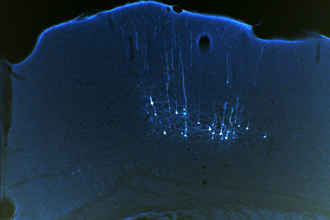Brain research: Mice sing and share songs like humans
Not only do mice sing and serenade other mice, fulfilling Disney-inspired fantasies of children everywhere, they also have the ability to learn songs from each other, remember these songs and change pitch. A new study claims that mice have the same brain features and behavior traits for vocal learning as humans, birds and dolphins.

This image shows the motor cortex neurons that directly project to the brain stem and ultimately control the larynx of male mice. (Photo from Gustavo Arriaga and Erich Jarvis, Duke University)
“While at Duke, my interests in neuroscience and music converged into exploring the mechanisms and intricacies of vocal learning,” explains Zhou. “As an undergraduate researcher and co-author, my role in the project was to help design and implement our experiments that were described in the paper.”
The results are controversial because they contradict long-standing beliefs in the scientific community that mice, like most animals, do not learn songs and cannot modify pitch on demand functions that occur in the forebrain region of humans and birds.
“Our particular study is important in that it challenges the 50-year-old assumption that mouse vocalizations are innate,” says Zhou. “Our experiments confirmed the presence of five important features in mice that have been shown to be unique to vocal learners: direct cortical to vocal motor neuron connectivity, forebrain activation, forebrain control, vocal imitation and auditory feedback.”
Most importantly, says Zhou, the findings demonstrate that mice may be able to be used as a mammalian model to research relevant human neuropsychiatric disorders such as Tourette syndrome, autism, Parkinson's disease, social disorders and spasmodic dysphonia.
